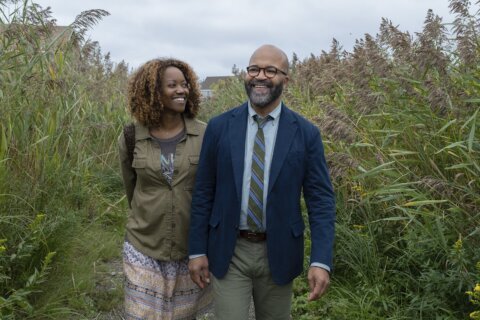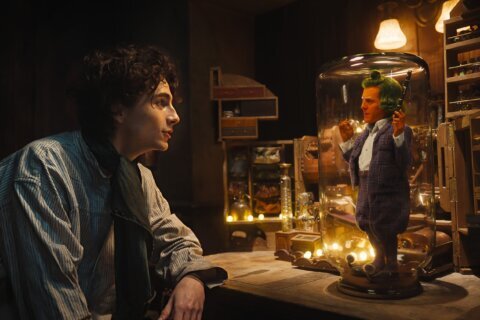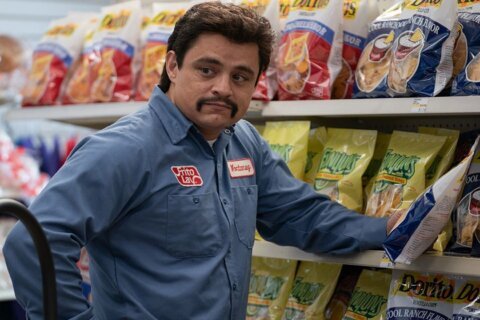WASHINGTON — I first saw a clip from “The Act of Killing” during last summer’s AFI Docs tribute to Errol Morris (“The Thin Blue Line”), who executive-produced the film alongside Werner Herzog (“Grizzly Man”). It was one of the most unusual pieces of filmmaking I’d ever witnessed, blending standard documentary interviews with bizarre reenactments of real-life atrocities through “fictional” Hollywood scenarios.
“The Act of Killing” has been nominated for best documentary at next week’s Academy Awards, and with the backing of such legends as Morris and Herzog, it could very well win. Director Joshua Oppenheimer interviews former Indonesian death squad leaders who killed a million suspected Communists after a 1965 military coup.
The two central figures – the fragile, tormented Anwar Congo and his overweight, buffoonish sidekick Herman Koto – recount the executions in gruesome detail. But because they’re such fans of exported American pop culture, they reenact the deaths in Hollywood genres of their choosing, from gangster pictures to lavish musical numbers. The result puts the viral sensation “Kony 2012” to shame. Imagine if you convinced Joseph Kony to reenact his brutal murders, then showed him the tape, and watched him cry at the horrors he committed. That’s “The Act of Killing.”
Watch a teaser below:
Perhaps Oppenheimer was uniquely suited to chronicle man’s inhumanity against man. He was born in Texas in 1974, the same year “Texas Chain Saw Massacre” was released, and moved to our area when he was just a year old. He bounced around from Capitol Hill to Takoma Park to Chevy Chase, splitting time living with his mother in Santa Fe, N.M. But it was the science magnet program at Silver Spring’s Montgomery Blair High School that inspired him to attend Harvard University.
“I went to college initially thinking I’d study theoretical physics because I was interested in the nature of existence and, in some ways, I see my explorations in film as a continuation of that,” he says.
After Harvard, Oppenheimer lived in London from 1997 to 2010, then moved to Copenhagen, Denmark, where he lives now. So how did he become so fascinated with Indonesia?
He first visited the country in 2001 to shoot a documentary about a group of plantation workers under a Belgian company in Medan, 60 miles from where he would go on to make “The Act of Killing.” These plantation workers were forced to spray a weed killer without wearing any protective clothing. The mist got into their lungs and bloodstreams, dissolving their liver tissue. Despite the health concerns, the workers were afraid to organize a union because their unionized parents and grandparents had been killed as suspected communists by the Pancasila Youth, an Indonesian paramilitary organization.
When Oppenheimer returned in 2003, the army would not allow the survivors to participate in the documentary. Oppenheimer instead approached the perpetrators to see whether they wanted to be the subject of the film. They eagerly agreed despite having taken part in a genocide.
“I found, to my horror, that every single one of them was boastful, openly recounting the grisly details of the killings, often with smiles on their faces, often in front of their families and even their little grandchildren. I felt as though I had wandered into Germany 40 years after the Holocaust, only to find the Nazis still in power,” Oppenheimer says.
When he showed the material to human-rights advocates in Indonesia, they told him he was onto something important and begged him to keep shooting. Oppenheimer spent the next two years filming every perpetrator he could find, and after 41 perpetrators, he finally found Anwar Congo. Immediately, he knew Congo would be the central figure of his documentary. Their first meeting is featured early in “The Act of Killing,” as Congo takes us to a rooftop, shows us how he killed hundreds of people with a wire around their throats and then gleefully dances the cha-cha.
“It was one of the most grotesque images of impunity that I had filmed up to that point, and yet he says he was a good dancer because he’s been drinking and going out dancing to forget what he’s done, to forget the trauma of what he’s done. This really struck me, that the boasting and trauma were two sides of the same coin,” Oppenheimer says.
“They’re justifying what they’ve done to themselves so they don’t have to admit what they know – namely, that it was wrong – and they’re imposing that victor’s history, that celebration, that justification, on this whole society with the threat of violence.”
Oppenheimer was so intrigued by Congo that he spent five years filming him in his community. Oppenheimer couldn’t promise immunity for his participation because international law has no statute of limitations for crimes against humanity.
So without that guarantee, how did he get war criminals to admit heinous crimes on camera for the entire world to see?
“For them to even show hesitation about telling me what they did … would be to admit what they did was wrong, and they’ve never been forced to do that,” Oppenheimer says.
“On the contrary, they knew that my government, the American government, not only supported what they did, but participated in it, providing weapons, money, training and lists of thousands of Indonesian public figures and intellectuals whom the U.S. wanted dead.”
Oppenheimer suggests the American crossover is not only political but cultural. Exported American cinema inspires Congo and his friends – who call themselves “movie-theater gangsters” and constantly remind us that “gangster” means “free man” – in a twisted extreme version of capitalism.
“The most powerful example that Anwar gives of a movie influencing behavior is not a gangster film, but it’s an Elvis Presley musical. He says, ‘I would watch an Elvis Presley musical, come out of the cinema intoxicated by my love for Elvis, dance my way across the street, and in such moments I was able to kill happily.’ It’s as though movies helped him distance himself from the act of killing while he was killing. Acting, in that sense, was always part of the act of killing for Anwar,” Oppenheimer says.
He adds that this illustrates the “danger of escapism.”
“The real risk is not so much that our movies are violent, but I think there’s a real problem when our whole culture industry and our media is not about providing a forum for reflecting on our most painful, difficult and important problems, but escaping from actually confronting who we are as human beings and what we’ve done,” Oppenheimer says.
Therein lies the difference between, say, “12 Years a Slave” and “Gravity.” The former mournfully reflects on our most painful history, while the latter provides mesmerizing popcorn escapism. Both films are masterpieces from strong directors who understand the cinesthetic language. It’s up to us, the viewers, to discipline ourselves – and raise our children – to appreciate both types of movies. This is the only way we proceed as humankind to make this world a better place.
This disconnect between actual atrocities and popcorn escapism is what fuels Congo’s reenactments. Every dramatization was left up to his creative expression, understanding that he’s not making a feature-length fiction film, but segments for Oppenheimer’s documentary.
“Show me what you’ve done, in whatever way you wish,” Oppenheimer says. “I will film your reenactments, but I will also film you and your fellow death squad members discussing what you want to show and what you don’t want to show and, therefore, document how you want to be seen, how you see yourself, how you imagine this will be seen by the rest of the world.”
Oppenheimer added that “the scenes became more and more wild, more and more surreal, more and more strange and more and more frightening” the more than Congo was allowed to create his own interpretations. The gangster scenes feature noir lighting and hardboiled interrogations. Meanwhile, the musical number unfolds by a waterfall with a cross-dressing Koto dancing and a victim putting a medal around Congo’s neck, thanking him for sending him to the afterlife.
But even after witnessing his own staged salvation, Congo would rather watch a scene in which he plays a victim of his own genocide. It’s as if he knows the core of his torment lies here. With his grandchildren on his lap, Congo watches himself being “tortured” as if a mirror of the past.
“Did the people I tortured feel the way I do here?” he asks.
“I can feel what the people I tortured felt because here my dignity has been destroyed and then fear comes, right there and then. All the terror suddenly possessed my body.”
“Actually, the people you tortured felt far worse, because you know it’s only a film. They knew they were being killed,” Oppenheimer replies.
A look of shock forms on Congo’s face, as if he’s never even considered this.
“But I can feel it, Josh. Really, I feel it. Or have I sinned?”
At this point he breaks down into tears.
“In that moment, the bottom drops out for him and he recognizes the meaning of what he’s done; he’ll never be able to bridge the abyss between all the lies he’s told himself,” Oppenheimer says.
“I did this to so many people, Josh. Is it all coming back to me?” Congo asks.
The horror comes back to him most during the film’s final scene as he takes us back to the scene of the crime for one last visit. As he tries to explain the killings, something chillingly unexpected happens. Congo doubles over with hands on his knees in a fit of dry heaving. Each time he tries to speak, he doubles over again, his stomach convulsing, his mouth emitting a horrific sound.
“When Werner Herzog saw that scene, he said it’s as though the angel of vengeance has descended upon him, as though he’s trying to vomit up the ghosts that haunt him, only to find that nothing comes up, because what haunts him is his past,” Oppenheimer says.
Herzog’s input was extremely helpful to Oppenheimer. He met the filmmaking legend through his British executive producer, Andre Singer, who had produced Herzog’s documentary “Into the Abyss” (2011).
Oppenheimer met the equally legendary Errol Morris much earlier in the process through one of his college mentors, Alfred Guzzetti. In 2009, Morris saw some roughly edited scenes and lent his name to the project to help raise more money. How fitting that the man who had invented documentary reenactments in “The Thin Blue Line” was now helping complete “The Act of Killing,” which gloriously and horrifically blurs the lines between fiction and reality.
Herzog, Morris and Oppenheimer are some of the few names in the end credits. Most of the crew members are listed as “Anonymous,” as they were Indonesian citizens still fearing Congo and his men. It’s important to remember that this movie isn’t over. Even if “The Act of Killing” wins the Oscar next week, the next chapter remains unwritten. These barbaric leaders are still alive, well and unpunished.
Will there be any retribution? The International Criminal Court can’t pursue this case because it happened before the court came into existence. But an international tribunal could act, as they did in the former Yugoslavia, if the United Nations Security Council makes it a priority.
“Given that the United States and the United Kingdom are permanent members of the Security Council and were both involved with supporting and implementing this crime, the first step would really have to be for the United States to step forward, set an example and show leadership by declassifying all the documents pertaining to what we did,” Oppenheimer says.
“Fifty years is long enough for us to get comfortable with actually what happened and to actually start calling a genocide a genocide.”
You can watch “The Act of Killing” on Netflix instant watch, iTunes and On Demand.
★ ★ ★ ★
The above rating is based on a 4-star scale. Follow WTOP Film Critic Jason Fraley on Twitter @JFrayWTOP, read his blog The Film Spectrum or listen Friday mornings on 103.5 FM.
Follow @WTOP and @WTOPliving on Twitter.








